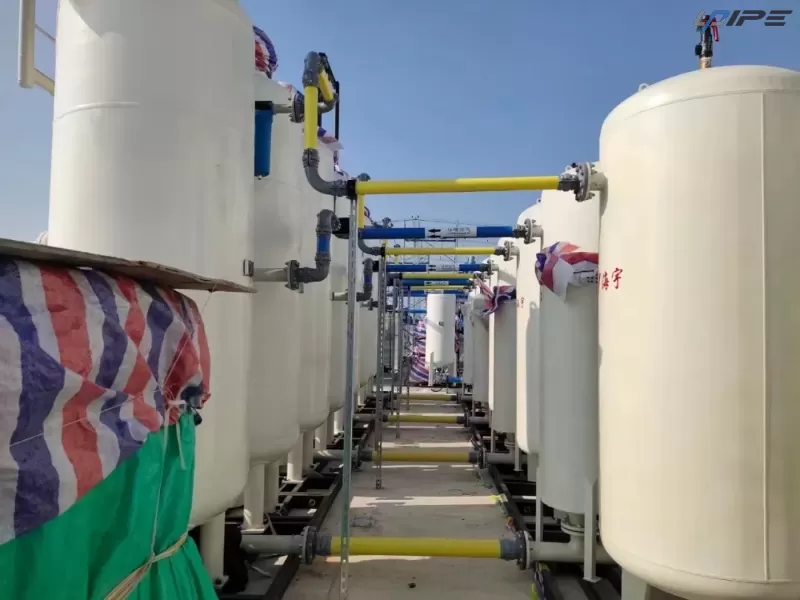As high performance aluminum air pipe line exporter, UPIPE will share the benefits of high pressure aluminum compressed air pipe for sale, its applications, etc.
Learn more
Aluminum alloy compressed air pipelines, as critical infrastructure in modern industrial applications, are being widely adopted across various sectors. These pipeline systems leverage their unique material advantages to provide efficient and reliable solutions for compressed air transportation in different fields.
First and foremost, aluminum alloy offers significant lightweight properties, weighing only about one-third of traditional galvanized steel pipes. This characteristic greatly reduces transportation and installation costs, making it particularly suitable for elevated and large-span installations. Additionally, the naturally formed oxide layer on aluminum surfaces provides excellent corrosion resistance, eliminating the need for additional anti-corrosion treatments while delivering a service life exceeding 30 years—an essential feature in humid or corrosive environments.
In the manufacturing sector, aluminum alloy compressed air pipelines demonstrate exceptional adaptability. Automotive plants utilize them in body welding production lines to supply stable air to hundreds of welding robots; in painting systems, they ensure consistent spray gun pressure for improved coating quality; and on assembly lines, they power various pneumatic tools and positioning devices. The electronics manufacturing industry values their cleanliness, as aluminum alloy pipelines effectively prevent rust contamination in sensitive production environments for semiconductor fabrication and PCB manufacturing. A notable case study reveals that a German automaker reduced system pressure drop from 0.6 bar to 0.2 bar after switching to aluminum alloy pipelines, achieving annual energy savings of approximately ¥180,000.
The energy and chemical industries impose even stricter demands on pipeline systems, which aluminum alloy pipelines meet with ease. In petrochemical applications, their superior salt spray corrosion resistance makes them ideal for offshore platforms; they provide safe and reliable transportation solutions in refinery explosion-proof zones; and they deliver clean, dry instrument air to control valves—all while complying with stringent safety standards such as API RP 505. The power industry also benefits significantly, whether in thermal power plants' instrument air systems, nuclear-grade pipelines (meeting ASME NQA-1 standards) in nuclear power stations, or yaw and pitch systems in wind farms.

The food and pharmaceutical industries require exceptionally high hygiene standards, where aluminum alloy pipelines excel. In food processing, FDA-certified food-grade aluminum alloy pipelines prevent lubricant contamination risks in filling lines and packaging machinery. A case study from a leading dairy company showed a 70% reduction in product contamination rates after adopting aluminum alloy pipelines. The pharmaceutical sector demands even stricter controls—sterile production lines must meet GMP cleanliness requirements, and biopharmaceutical processes cannot tolerate any leaching contaminants. Aluminum alloy pipelines not only meet these standards but also provide complete material certifications and validation documentation.
Aluminum alloy compressed air pipelines are also extensively used in infrastructure development. In rail transit, subway stations rely on them for platform screen doors and control systems, while high-speed trains use them for brake systems—all compliant with EN 45545-2 fire safety standards. In airport facilities, they supply air for boarding bridge hydraulic systems, baggage handling pneumatic transport devices, and de-icing systems critical for winter operations.
Selecting and installing aluminum alloy compressed air pipelines requires careful attention to technical details. Pipe diameter calculations should use specialized formulas to ensure an economical flow velocity of 6–10 m/s. Pressure ratings must align with actual needs, with low-pressure systems (0.7–1.0 MPa) typically sufficient for general industrial use. During installation, a slope of 0.5%–2% must be maintained, with drainage points at the lowest sections; specialized supports should be spaced according to pipe diameter; wall penetrations require sleeves; and connections between different materials need insulating joints.
A robust maintenance system is key to ensuring long-term reliability. Routine inspections should include leak detection (recommended quarterly ultrasonic testing), drain trap functionality checks, pressure fluctuation monitoring, and support condition assessments. Performance monitoring should focus on core metrics: mainline pressure drop should not exceed 0.1 bar/10 m, oil content must stay below 0.01 mg/m³ (Class 1 standard), and dew point should be at least 10°C below ambient temperature. Modern aluminum alloy pipeline systems can integrate smart monitoring features, including wireless pressure sensors, flow monitoring modules, leak detection systems, and cloud-based data analytics platforms for optimized operations.
Looking ahead, aluminum alloy compressed air pipeline technology will continue evolving. Nanocoating applications will further enhance inner surface smoothness to minimize pressure loss; modular designs will enable rapid deployment of prefabricated sections; smart pipeline systems will incorporate more sensors and AI-driven predictive maintenance; and green manufacturing processes will reduce carbon footprints by over 30%. These advancements will solidify aluminum alloy pipelines' dominance across industries.
In summary, aluminum alloy compressed air pipelines are rapidly replacing traditional steel systems, with their superior performance perfectly aligning with modern industry demands for energy efficiency, reliability, and environmental sustainability. Proper selection, installation, and maintenance can deliver substantial energy savings and operational improvements, making these pipelines indispensable for industrial modernization. As technology progresses, their applications will expand even further.